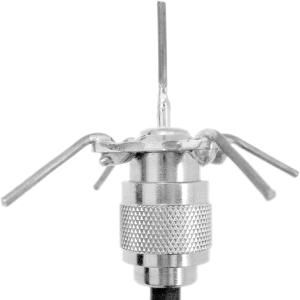“Spider” Omni
Possibly the smallest and simplest omnidirectional antenna there is.
This is one of the simplest and smallest antenna designs I’ve seen for 2.4 GHz. It isn’t much larger than a standard N connector—because that is exactly what it is made of. It has been dubbed the spider omni , since it looks a bit like a crazed spider crawling up your antenna feed (Figure 5-3). Technically, it is a ground plane antenna, but practically speaking, it acts like a vertically polarized 3 dB omni.

Figure 5-3. A spider omni.
The spider is very simple to construct if you have a good soldering iron and some basic tools. You need a standard N connector and about a foot or so of solid copper 12-2 romex (common 12-gauge electrical wiring). You also want a good vice to hold onto the pieces as you solder them, as well as a pair of needle nose pliers, some good solder, and a bottle of flux.
First, cut five pieces of bare copper romex, each about 3 cm long. Straighten out each piece as best as you can. Using needle nose pliers, make a small 180-degree bend on one end of four of the pieces. Now, tin the bent tip of each piece, as well as one end of the remaining straight piece. This will make your soldering job much easier later.
Tip
If you don’t know what tinning is, you may want to get the help of a friend who has experience with soldering. To tin means to cover the end of a piece of wire with solder ...
Get Wireless Hacks now with the O’Reilly learning platform.
O’Reilly members experience books, live events, courses curated by job role, and more from O’Reilly and nearly 200 top publishers.

